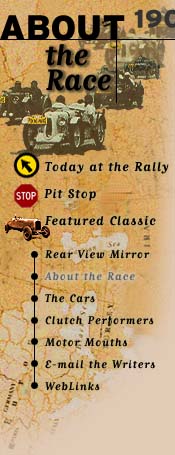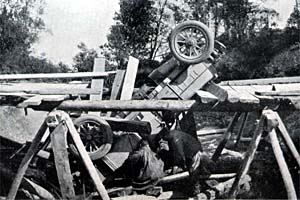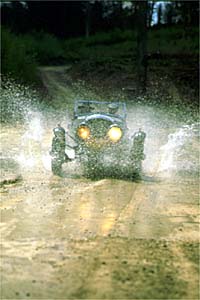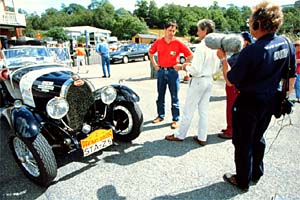
|
The 1997 Peking to Paris Motor Challenge is the second running of the world's first international motor rally. The original Peking to Paris, held in 1907, was billed as "the most extraordinary race yet, an international competition among men, industries and diverse conceptions of the ideal machine of the future." In short, it was a grand stunt designed to popularize the "motor car," and jump start the greatest transportation revolution since the invention of the steam train in 1804. The first Peking to Paris, with its noisy, open jalopies, and goggled drivers in sheepskin coats, expressed the spirit of an age when Zeppelins droned in the skies above, and steam-powered carts chugged past frightened horses on cobbled streets below. It was a world where paper boys called out headlines from Arctic expeditions, and H.G. Wells' The Time Machine was on everyone's summer reading list. "Progress" seemed an immutable law of the universe and machines promised freedom and prosperity to the masses.
 An Itala roadster overturned by the collapse of a bridge
during the 1907 Peking to Paris Road Rally
An Itala roadster overturned by the collapse of a bridge
during the 1907 Peking to Paris Road Rally
At the turn of the century, automobile clubs and associations on both sides of the Atlantic began evangelizing the public and lobbying governments on the advantages of motoring. In a 1905 essay, appropriately entitled Anticipations, H.G. Wells offered his own endorsement of the automobile, calling it a "revolution in personal mobility." Hoping to capitalize on all this hype, the editors of the French newspaper Le Matin issued the following challenge in March 1907: "As long as a man has a car, he can do anything and go anywhere. That is the boast of the infant automobile industry. All right! We ask this question: Is there anyone willing to travel this summer from Paris to Peking by automobile?" Five drivers accepted the challenge, and after months of planning, began a 10,000 mile, 62-day adventure that captured the world's attention. Four of the cars would ultimately finish the race, but the hands-down winner was an Italian prince, accompanied by a reporter for London's Daily Telegraph. Public interest in the race ran high. And by the time the pair crossed the finish line - three weeks ahead of the pack - an estimated six million people had read daily dispatches of marauding nomads, bomb-tossing bolsheviks and opium-smoking magistrates. Later, a book about the race appeared in 13 languages and remained a best-seller in Italy for more than 30 years.
 Some of the participants in the
Some of the participants in the 1997 Peking to Paris Motor Challenge It has taken Britain's Classic Rally Association four years to organize this long-awaited sequel, including 18 months of diplomatic pussy-footing to guarantee safe passage. The result is a course even more dramatic than the original route which took the competitors across the flatlands of Mongolia and Siberia. Instead, the rally's 200 competitors in 94 cars will drive between 300 to 500 miles each day, across 11 countries. After passing through China's Gobi desert, the racers will ascend the besieged mountain nation of Tibet, skirt Mount Everest and then drop from Nepal into the explosive border regions between India and Pakistan. Traveling a road that the Lonely Planet dubbed "the most dangerous highway in the world," the rally will bisect the Islamic Republic of Iran and weave through the rebellious Kurdish regions of Turkey, before continuing on to Europe and the finish line in Paris. And unlike the 1907 route, most of the roads are paved.
 Chris Dunkley drives his 1935 Bentley Special through rough terrain. And then there are the cars. The race is a "vintage" motor rally, open only to select, pre-1968 automobiles -- from hand-crafted Rolls-Royces and painstakingly engineered Mercedes Benzes, to the war-horse Willys Jeep, to the sturdy, no-nonsense "people" cars of Peugeot, Citroen and Volkswagen. These cars will be driven by princes, nobles and captains of industry, alongside businessmen, doctors, school teachers, mechanics and housewives -- a testament to the broad, consumer-oriented economy that began when Henry Ford introduced the first cheap, mass-produced Model T in 1908.
 Driver Walter Rothlauf (in red shirt)
Driver Walter Rothlauf (in red shirt)and his 1928 Bugatti Tourer If the first Peking to Paris heralded the coming of the auto, the second confirms that the car has not only arrived -- it's here to stay. In the past 90 years the nations of the world have produced hundreds of millions of automobiles, paved millions miles of road and placed the car at the center of such modern concepts as the suburb, the fast food restaurant and the shopping mall. When the starting gun fires on the morning of September 6, 1997, history will sound like 99 roaring engines, embarking on the "most extraordinary race yet" -- The Race of the Century. Pictures: Popperfoto/Archive Photos | Auburn Museum/Archive Photos | Mondadori Press | Candide Media Works | Copyright © 1997 Discovery Communications, Inc. |